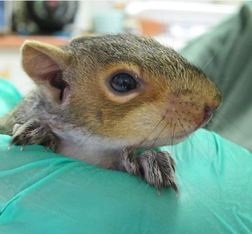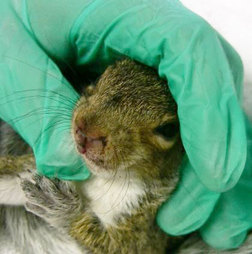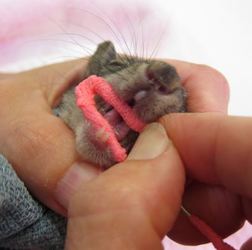
Baby squirrels have large heads, which means when they tumble from their nests high in the trees, they often land head- or face-first.
This is exactly what happened to this baby eastern gray squirrel.
She arrived at the Wildlife Hospital with a bloody nose, a split lip, and, worst of all, her two upper teeth completely broken off.
Fortunately, due to the prevalence of tooth injuries in baby squirrel patients, WildCare Director of Animal Care Melanie Piazza has become something of an expert in squirrel dentition. Under her care, this baby's teeth should regrow... but it is quite a process!

This is a necessary adaptation, as rodents use their strong jaws and teeth as their primary tools for everything from cracking into food to accessing den space. For instance, beavers use their constantly growing teeth to cut down trees for their dams. Squirrels need their sharp teeth not only for self-defense but to crack open many of the foods they like to eat, such as hard-shelled nuts and acorns. Can you imagine being able to crack open a walnut with your teeth?
A squirrel would not be able to survive without his specialized teeth, but fortunately for baby squirrels like this one, this characteristic of rodent teeth means broken or lost incisors aren't a death sentence, as long as they grow back in properly. This is where WildCare Medical Staff comes in: It is of the utmost importance that regrowing teeth properly align.
The Treatment Plan
 After having her bloody nose, split lip and broken teeth cleaned, this baby squirrel was given subcutaneous fluids to combat the dehydration from blood loss, the stress of her ordeal and the time she spent on the hot sidewalk before she was rescued. Then she was started on a course of antibiotics (to prevent a gum infection) and anti-inflammatory pain medication and was given some time to rest and recover. Once stable, she was offered Pedialyte from a syringe with a soft nipple tip so as to be gentle on her sore gums, and to help her digestive system transition from her mother's milk to our formula.
After having her bloody nose, split lip and broken teeth cleaned, this baby squirrel was given subcutaneous fluids to combat the dehydration from blood loss, the stress of her ordeal and the time she spent on the hot sidewalk before she was rescued. Then she was started on a course of antibiotics (to prevent a gum infection) and anti-inflammatory pain medication and was given some time to rest and recover. Once stable, she was offered Pedialyte from a syringe with a soft nipple tip so as to be gentle on her sore gums, and to help her digestive system transition from her mother's milk to our formula.
She will go into foster care with a trained squirrel-care volunteer, where she will receive formula feeds from a syringe approximately every four hours (that's around the clock!) for the next few weeks as her teeth grow in.
During this time she will also have regular appointments with medical staff for dental exams. Because the bottom teeth are the longest and this patient's are completely intact, they will keep growing. It is of the utmost importance to keep these bottom teeth trimmed for two reasons: so that the upper teeth can grow in to the length they need to be before being worn down, and so that the bottom teeth don't overgrow into the roof of her mouth.
In order to obtain this balance, the teeth must be clipped and filed once a week. Fortunately rodent teeth don't have the same nerves as human teeth, so the trimming and filing doesn't hurt the patient. It is stressful, however, as going to the dentist is for most of us!

This allows them to get to the teeth without being bitten (a major consideration when dealing with broken teeth on an adult squirrel patient!) while still allowing the squirrel to breathe easily.
The trimming and filing is done as quickly as possible, and the squirrel is returned to her cage with her foster-care sibling squirrels.
Thanks to the speed at which rodent teeth grow and this odd expertise of medical staff, this squirrel (and many others like her) will be chomping on nuts in no time.
With luck, this baby's teeth should regrow within two or three weeks.
